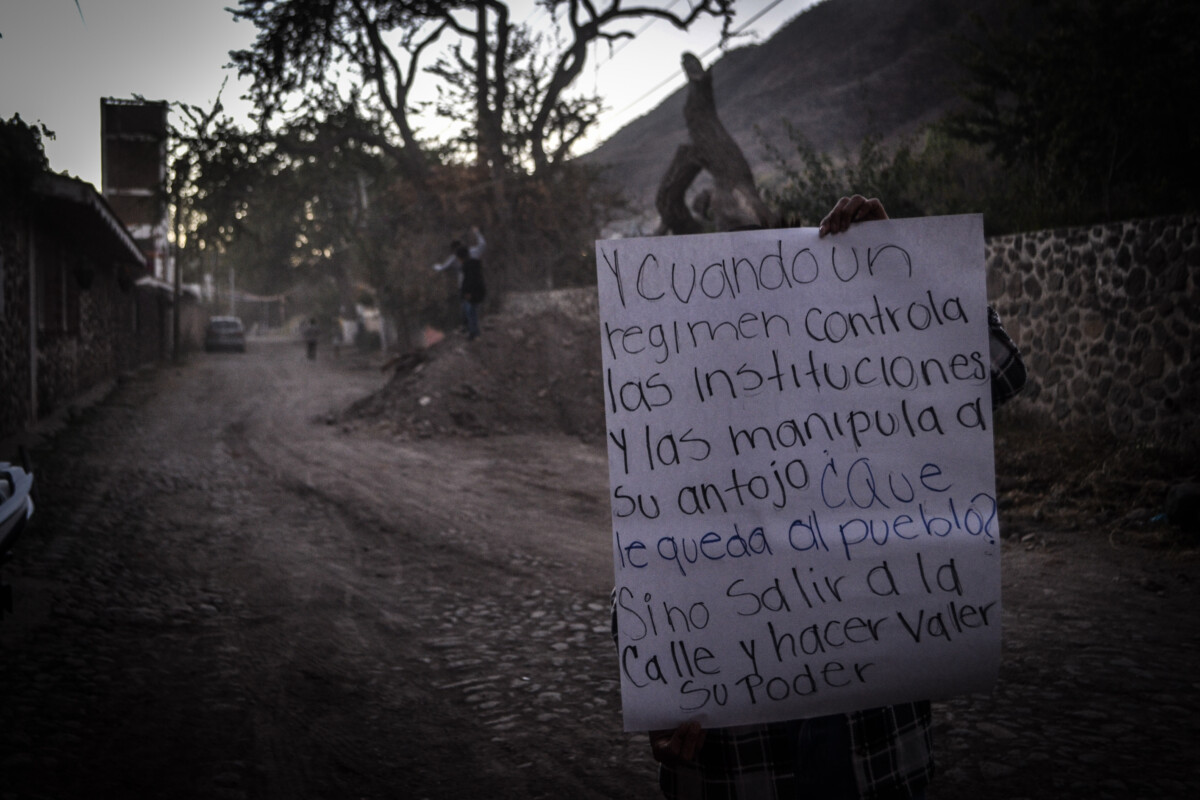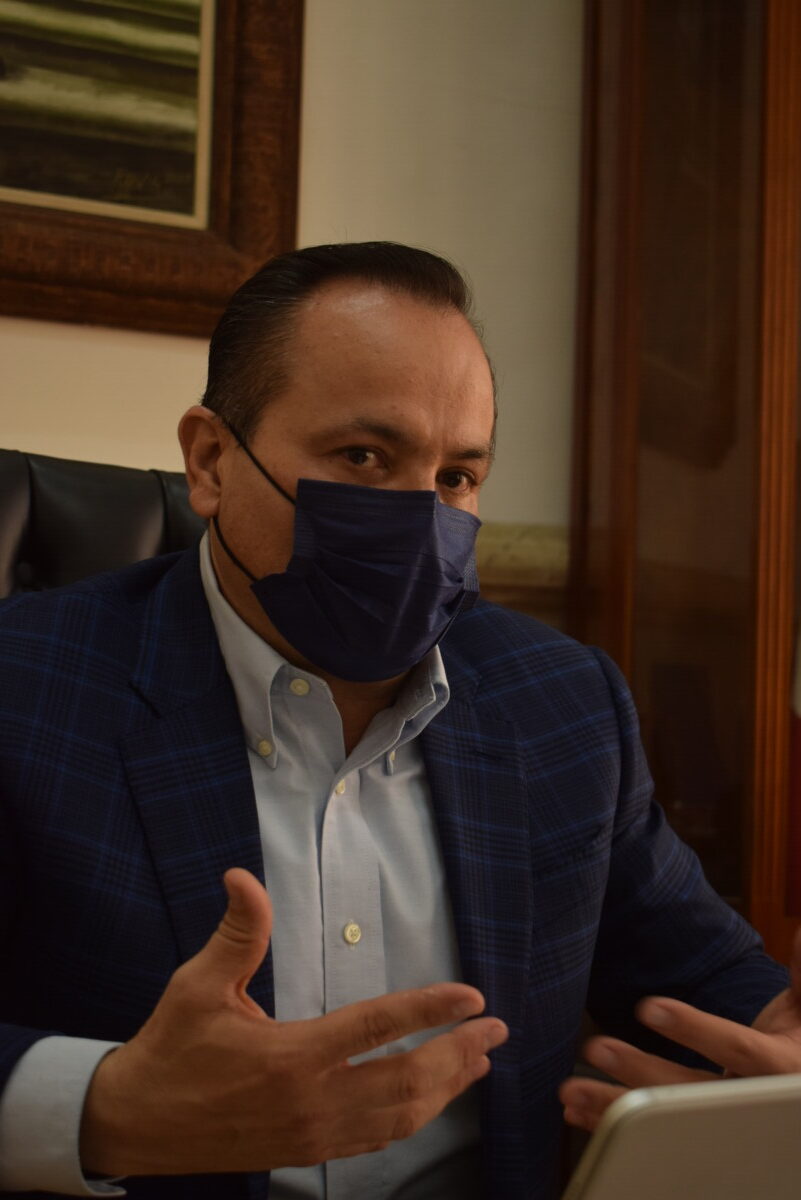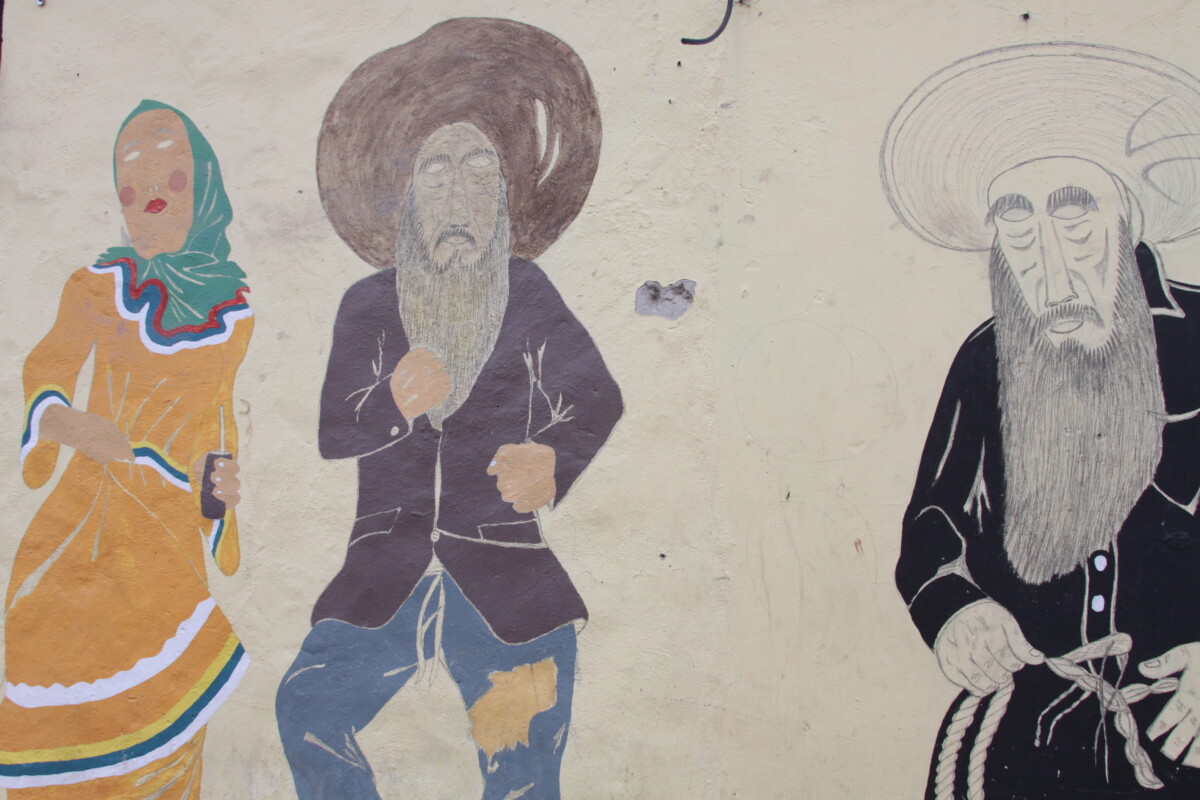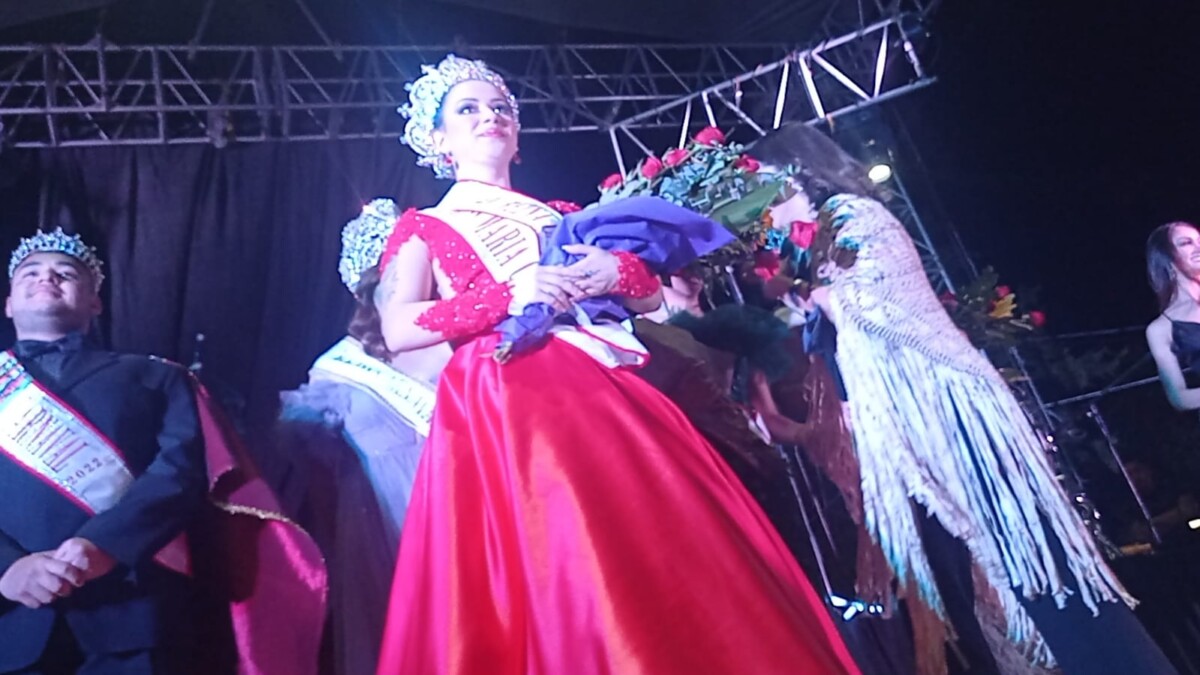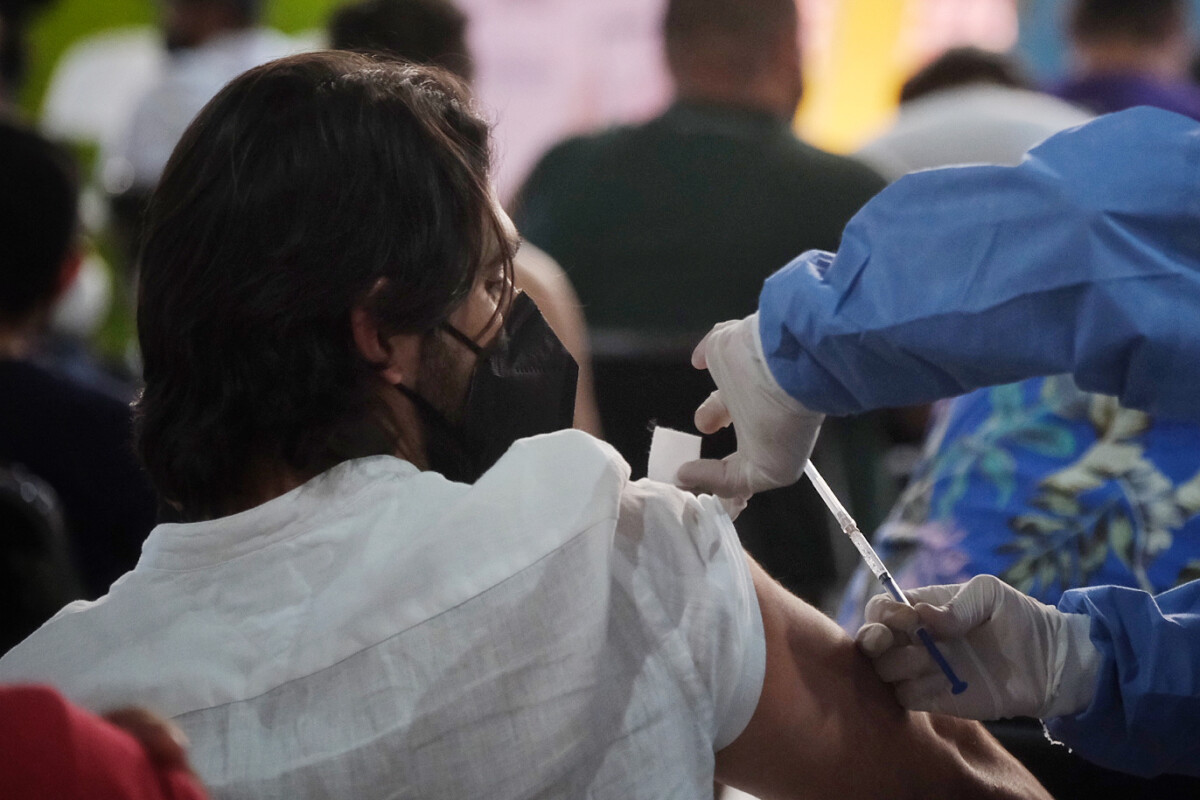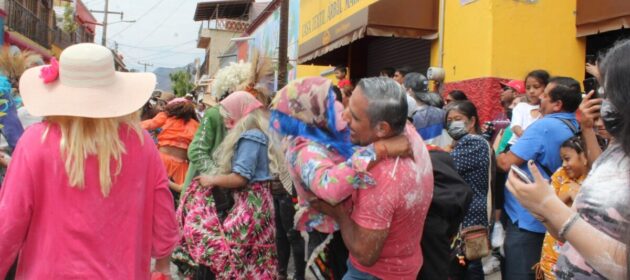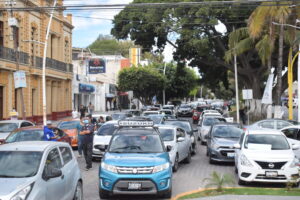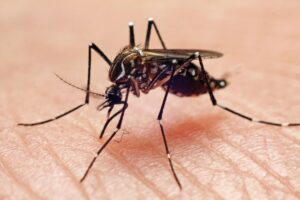Localidades
Talks resume between El Chante residents and City Council
Inhabitants of El Chante have expressed their disagreement with the project and the City Hall by means of signs and protests. Photo: Héctor Ruiz Mejía.
Héctor Ruiz Mejía (Jocotepec).- Residents of El Chante and the Municipal Government of Jocotepec resumed talks after disputes over a construction project to connect the water well that supplies water to the community with a real estate development located on Ribera Del Lago street, which has provoked anger and indignation in the residents.
Last Tuesday, February 15, negotiations were resumed when both parties met tgo try to mitigate the friction and inform the community about the project. The meeting was not attended by the municipal president José Miguel Gómez López, but the municipal trustee Carlos Alberto Zúñiga Chacón was present on his behalf, as well as the councilmembers Hugo García «Bombín» of FUTURO, José Manuel «Manolo» Haro Chacón of the Green Party, and Nancy Pérez Lupercio, Director of Citizen Participation.
The representatives presented a series of documents showing the «legitimacy» of the development under construction known as Ribera Capital Living S. A. P. I. de C. V., a multi-family housing development of 25 apartments. The project had legally obtained approval for its feasibility reports i, according to documentation delivered to the community.
Other documents presented included the surveyor’s report, the construction license granted under permit 2521/2018-2021, and payment vouchers for permits totaling 718,935 pesos.
The meeting ended with the inhabitants of El Chante agreeing that they will review the information received, but for the time being the project will remain suspended.
Protests were carried out by the citizens on February 4 and 8, where the protesters chanted “The people, united, will never be defeated,» and displayed banners with messages such as «This well is ours,” causing the closure of the dialogue with the City Hall.
José Miguel Gómez López sent a messge through his social networks that El Chante would be left without the support provided by the project, «despite the fact that the construction company had done everything right and that there would be other communities that would use the resources.”
Felipe Aguilar Montes de Oca, director of Social Communication, stated that, in the event of receiving a negative response from the community to the project for the renovation of water and sewage networks, the delegation of San Juan Cosalá is already being considered as the possible beneficiary.
Translated by Sandy Britton
The opening of formerly privatized streets in Chapala will continue
Alejando de Jesús Aguirre Curiel during an interview in his presidential office.
Jazmín Stengel (Chapala).– The campaign to recover public spaces will continue, declared Alejandro de Jesús Aguirre Curiel, president of Chapala, during an interview with the media on February 15.
When questioned by this reporter about whether the opening of privatized streets will happen in other subdivisions of the municipality, the mayor said that work is already being done in this regard. «As you have seen, we have already been working on it and we will continue,» he announced.
The first reopening of closed streets occurred in the Mirasol subdivision. This change provoked discontent from the subdivision’s residents. Aguirre Curiel reiterated that these streets will remain open, «The streets have to be open because the population of the area has grown.»
«The growth of the population is with its streets,» said the president, adding that the campaign to recover public spaces will not stop, as promised during my political campaign.
The authorities did not provide specific data on which streets will be reopened, nor how many subdivisions are in the same situation as Mirasol before this report went to press.
Translated by Nita Rudy
Lakeside Chronicles: The sayaco is the inner child
Front wall of the Romero Pérez brothers’ home is illustrated by masked Sayacos, created by Aarón, one of the brothers. Photo by: María del Refugio Reynozo Medina
María del Refugio Reynozo Medina (Ajijic).- José de Jesús Romero Pérez still has the first hermit-like sayaco mask he made 15 years ago. The dark brown, immobile, sharp face is made of copal, a wood that he brought from the hills. The hollows of the eyes and the slightly open mouth are decayed. The eyebrows, beard and straw-colored mustache are made of a fiber obtained from coffee sacks.
Making a mask can take José de Jesús about two and a half weeks, working in the afternoons after his usual workday. Although he does not make them for commercial purposes, the unique masks which bear his signature, can sell for up to three thousand pesos. The masks that depict women (sayacas) are colorful, with embossed or painted eyelashes and eyelids splashed with glitter. Once carved with a chisel, vinyl paint is used to outline the eyebrows, eyes and eyelashes. The lips and cheekbones are painted deep red circles.

Abel and José de Jesús Romero Pérez grew up watching the sayacos and chasing them in many celebrations. Photo by: María del Refugio Reynozo Medina
The male masks of the sayacos are made of natural light or brown wood, with long beards, bushy eyebrows and moustaches made of horsehair. Romero Pérez’s masks are instantly recognizable. The images flow, as he chisels each feature. A face will emerge unexpectedly from the wood. He knows perfectly well the type of wood needed to design each face. In addition to wood from the native copal tree, he uses native tecomaca wood, which is soft and light.
He has sold eight masks. Buyers do not necessarily wear them in parades. They are purchased by collectors as unique pieces, inspired by the sayacos.
The Romero Pérez brothers Abel, José de Jesús, Gaspar, José, Aarón and Modesto, each year transform themselves into sayacos mainly to inaugurate the carnival. They also attend other celebrations throughout the year.
On a wall outside their home there is an unfinished mural painting drawn by Aarón. The image shows a dancing female sayaca dancing wearing a yellow dress trimmed with colored ribbon and brown booties, accompanied by two male sayacos. One is dancing wearing a brown jacket, denim pants and booties. The other sayaco has a black dress with white dowels as buttons. All of them have long faces, although their appearance in the parades brings smiles and laughter.
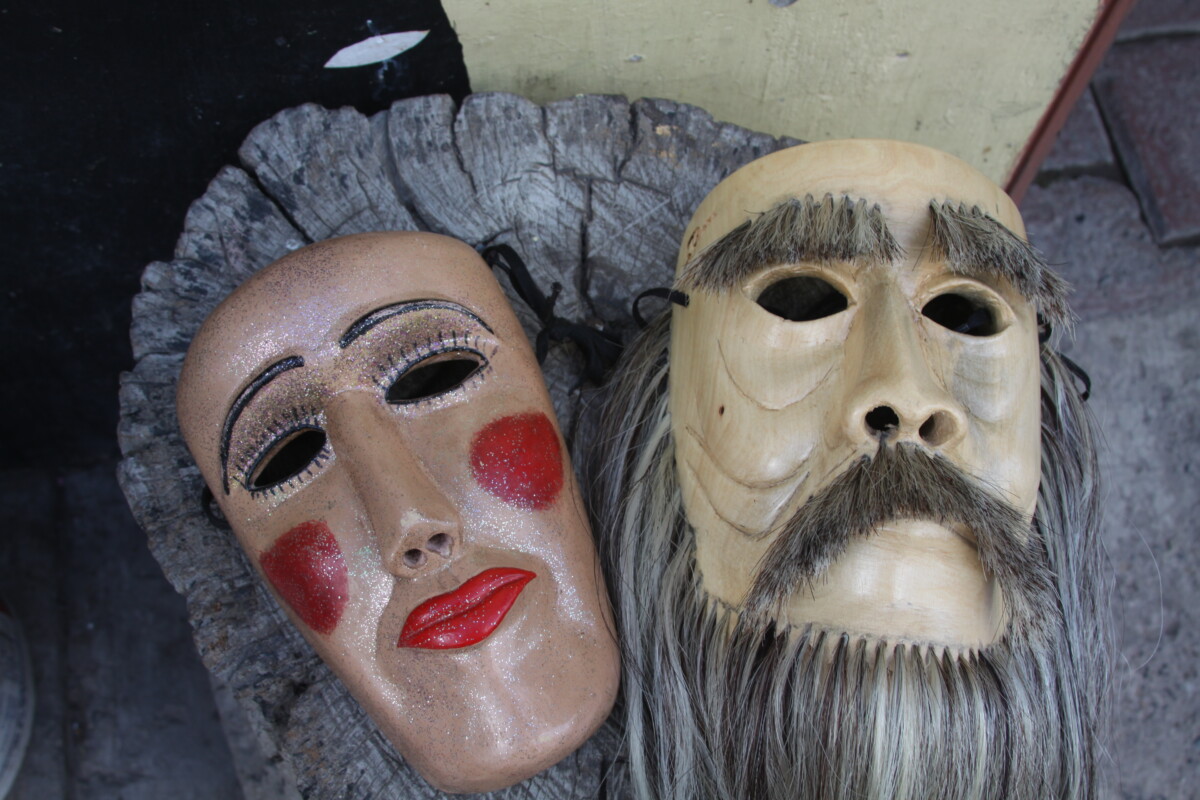
With copal or tecomaca wood, the masks made by Jesús Romero are unique pieces. Photo by: María del Refugio Reynozo Medina
“The sayaco is a very old character in the life of the people of Ajijic”, says Abel. They used to be called sayacal. Now they are called sayacas and sayacos. It is that mocking character that appears mainly in the carnival. They throw confetti and sometimes flour. Sometimes the flour is delicately smeared on their cheeks.
One of the main dances of the sayacos is called the dance of the «papaqui» which is accompanied by wind instruments. Sometimes they are invited to perform their dances at weddings or quinceañeras, the celebration of a girl’s 15th birthday. Abel remembers as a child watching the sayacos in the daily festivities. He and his siblings would race through the cobblestone streets following and teasing the sayacos amidst happy laughter.
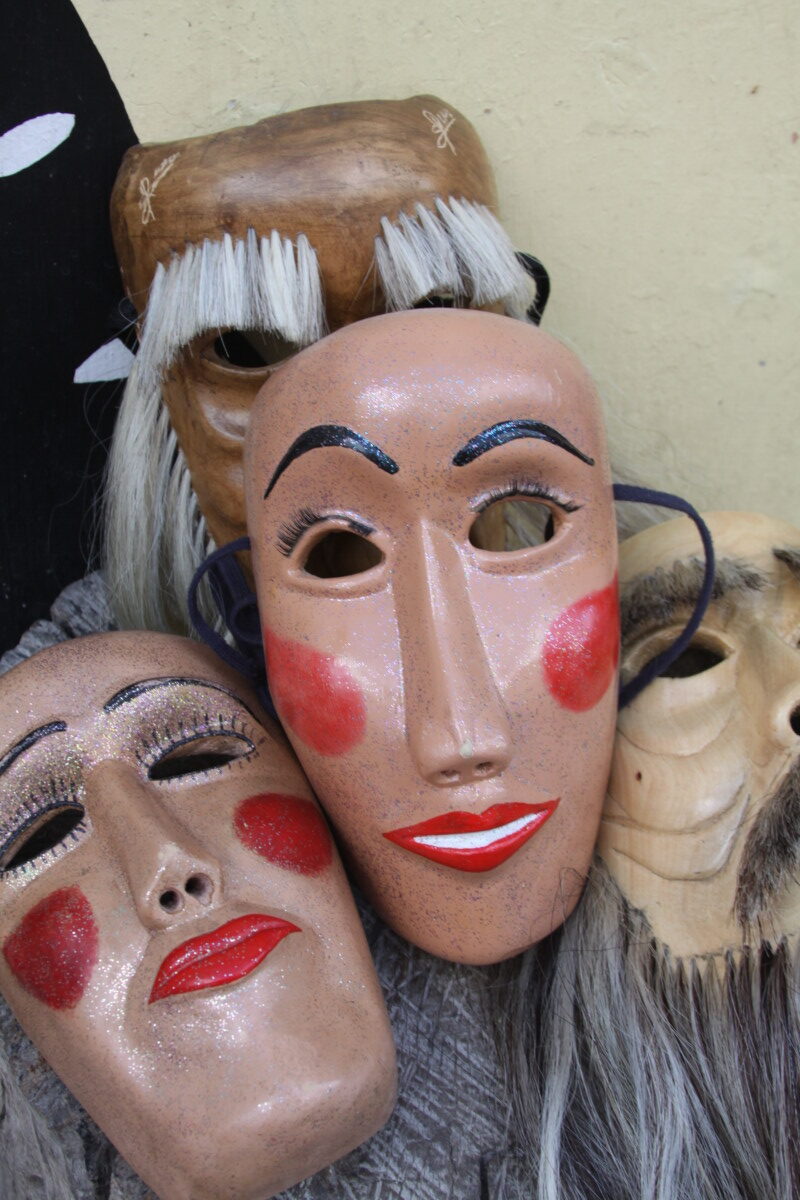
The masks of Jesus Romero Perez stamped with his signature can be worth up to three thousand pesos. Photo by: María del Refugio Reynozo Medina
The carnival parade is open to the entire population and a diversity of characters appear. The traditional attire is wooden or papier-mâché masks, sacks, shirts with dowels, booties, and hats. The sayacas wear bright printed dresses.
There is pride in being a sayaco. It is a nice, mocking, very old character who makes people laugh. The sayacos are mainly men. Even the sayacas are usually men because of the pushing, shoving, brawling atmosphere.
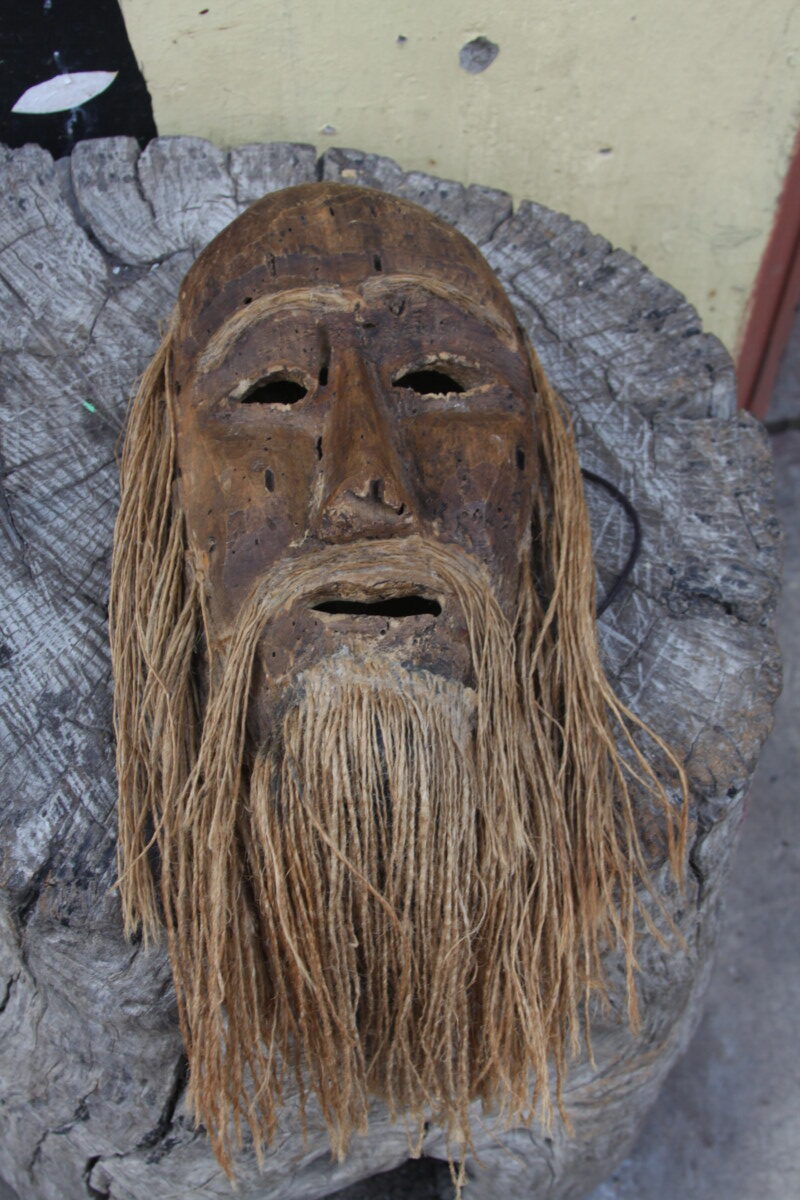
The first mask made by José de Jesús Romero Pérez was of a hermit in copal wood. photo by: María del Refugio Reynozo Medina
Behind the masks of tough men or picturesque red-cheeked women are the Romero Perez brothers. They appear in the parades and processions so that the legendary figures of the sayacos do not die and because Abel says «behind the wooden masks is the inner child.»
Translated by Nita Rudy
Coronan a María Alcalá como reina del Carnaval Chapala 2022
María Alcalá Ortiz fue coronada como la reina del Carnaval Chapala 2022 durante la noche del 25 de febrero.
D.Arturo Ortega.- María Alcalá Ortíz fue coronada como la reina del Carnaval Chapala 2022 el pasado 25 de febrero en el Lienzo Charro, J. Jesús González Gallo, de la cabecera municipal.
La reina del Carnaval 2020 – 2021, María Fernanda Ochoa Cárdenas cedió la corona a la nueva representante de los festejos, ante poco más de 300 personas; además de la presencia del alcalde, Alejandro de Jesús Aguirre Curiel quien acudió acompañado de la presidente del DIF, Erika Erín Torres Herrera.
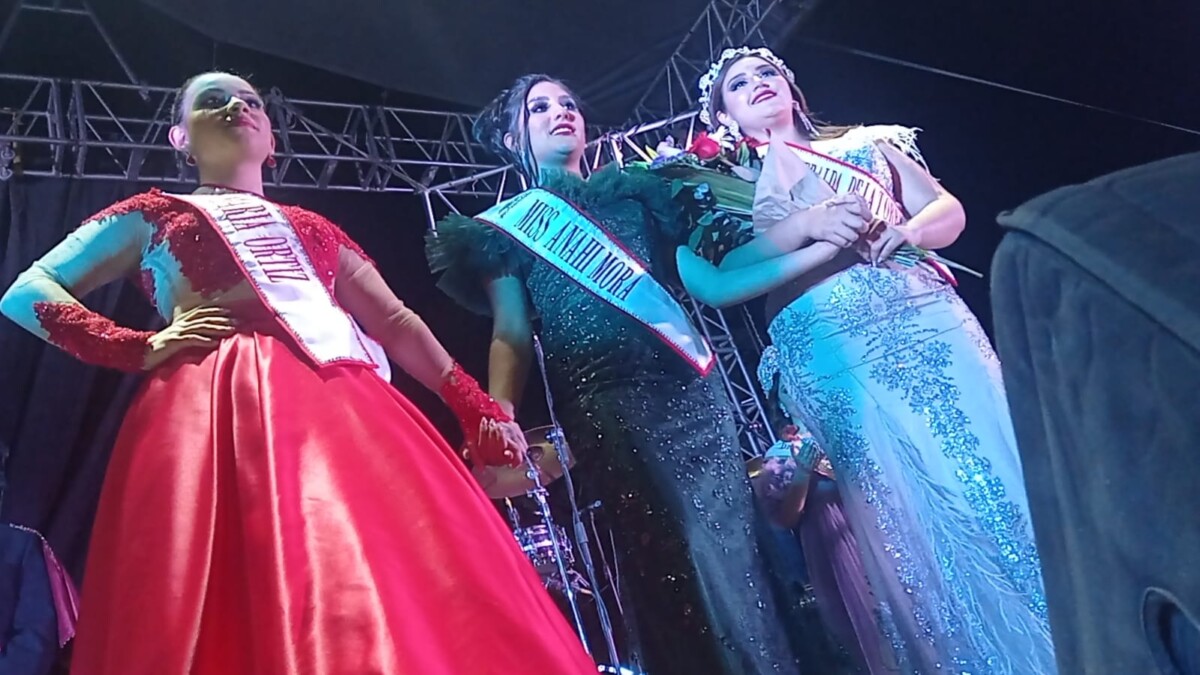
María Alcalá, Anahí Mora y Esmeralda de la Torre fueron las candidatas del certamen de este año.
Fue la noche del 25 en la que María Alcalá, Esmeralda de la Torre y Anahí Mora fueron confirmadas como las candidatas del certamen, luego de varias nominaciones que surgieron en las diferentes redes sociales.
Luego de la presentación y dos pasarelas en el que las participantes lucieron un atuendo casual blanco y uno de noche en el que María lució su belleza en un vestido rojo que; el jurado deliberó a favor de la nueva reina de la fiesta más grande de Chapala.
Casi 1 millón 300 mil jaliscienses han recibido el refuerzo contra COVID-19
Durante la semana epidemiológica ocho, se aplicaron 77 mil 444 dosis. Foto: SSJ.
Redacción.- Un millón 295 personas mayores de 30 años han acudido por el refuerzo de la vacuna contra COVID-19 a los distintos módulos habilitados en Jalisco, informó la Secretaría de Salud Jalisco (SSJ).
Durante la semana epidemiológica ocho del presente año, que fue del 20 al 26 de febrero, un total de 77 mil 444 personas acudieron a recibir alguna dosis de la vacuna para protegerse contra COVID-19.
En dicho lapso se suministraron 39 mil 657 dosis que corresponden a los laboratorios AstraZeneca, para segundas dosis y rezagados; 17 mil 296 de Moderna para segundas dosis; 12 mil 404 a laboratorios Pfizer-BioNTech para adolescentes; 7 mil 987 de la farmacéutica Cansino para refuerzo a mayores de 30 y 100 a Sinovac aplicada para segundas dosis.
Por lo pronto, la SSJ informó que la plataforma estatal continúa abierta para que la población de 30 años y más obtenga una cita y pueda acudir por la vacuna de refuerzo. Este día también hay citas disponibles para la cobertura de adolescentes de 15 a 17 años y para aplicar segundas dosis de AstraZeneca a las personas que ya les corresponde por fecha.
Respecto a la vacuna Cansino, que se está aplicando ahora como refuerzo la Secretaría de Salud Jalisco recordó a la población que se trata de un biológico aprobado por las autoridades sanitarias federales y contemplado dentro del Plan Nacional de Vacunación, por tratarse de una vacuna segura que ha demostrado su eficacia para proteger a las personas de las complicaciones graves y el riesgo de muerte por la infección del nuevo coronavirus.
CORTE SEMANAL
De acuerdo con datos de la SSJ, en Jalisco, durante la semana epidemiológica 08 de este año se registraron 7 mil 986 contagios nuevos (45.2 % menos casos nuevos respecto a los reportados la semana anterior), para un acumulado al 26 de febrero de 564 mil 119 casos. Se reportaron además 192 defunciones para un total de 18 mil 861 muertes registradas en lo que va de la pandemia hasta el pasado día 26. Los decesos pudieron ocurrir días atrás, debido al rezago en la notificación por parte de los hospitales.
Regresa el Carnaval al Pueblo Mágico de Ajijic
Las Sayacas bailaron e interactuaron con espectadores en múltiples ocasiones durante el recorrido.
Redacción.- Luego de un año de ausencia y por motivos de la pandemia, el carnaval regresó al Pueblo Mágico de Ajijic con todo su colorido, creatividad y tradición, por lo que Semanario Laguna te comparte una galería de imágenes de Sofía Medeles que muestran cómo han sido los primeros tres días del Carnaval que en ausencia de los carros alegóricos, las Sayacas y Sayacos se han lucido como nunca.

Cómo es tradición, decenas de jóvenes «cucaron» a las Sayacas con tal de que los «polvearan» con harina.

Desde el inicio hasta el fin del desfile, las Sayacas bailaron luciendo sus trajes multicolores.

Hay Sayacas que lucen coloridas faldas, son muy coquetas y se lucen bailando como las que se presentaron durante el tercer día de desfile.

Los y las jinetes también son parte importante para que un desfile sea tradicional.
After low sales, displaced Jocotepec merchants shift to neighboring towns
One month after relocation, merchants continue to record low sales. Photo: Héctor Ruiz Mejía.
Héctor Ruiz Mejía(Jocotepec).- After low sales, the former street vendors of Morelos and Josefa Ortiz de Domínguez streets who were relocated inside the Municipal Market, have begun to offer their products outside Jocotepec. The vendors have opted to sell their products in the neighboring town of Ajijic and even in Chapala to «make ends meet».
After almost a month of having been relocated to the second floor inside the market, with the purpose of «cleaning» the urban image and freeing the streets from street vendors, their sales continued to plummet.
Traders consulted by Laguna shared that in the new modules the average daily sales do not exceed 40 to 60 pesos; although on other occasions they have closed the day «at zero».
«The other day we had to throw away full boxes of guajes (edible green tree pods) because nothing is selling here anymore», commented Ana. The almost zero sales have also had an impact on her sister, who was left homeless because she could no longer pay the rent.
«Now we have a full house, my sister could no longer pay her rent and they threw her out and the truth is that now thanks to our support she was able to feed her baby, otherwise we don’t know what she would have done, she hasn’t sold a thing,» added the merchant.
Although those affected expressed their disagreement and proposed to return to the streets, specifically to the market access bench or to settle in the private Josefa Ortiz de Domínguez street, the Government of Jocotepec has not commented on the matter.
Translated by Kerry Watson
Visita Eva Longoria Mezcala
Eva Longoria tomándose una foto en Mezcala de la Asunción. Foto: cortesía.
Redacción.- La actriz mexico-estadounidense Eva Longoria estuvo de visita en Mezcala de la Asunción, en el lago de Chapala.
El motivo de su visita el mediodía del 24 de febrero, se debe a que Longoria se encuentra trabajando en un proyecto para grabar Searching for Mexico, serie que trata acerca de la comida mexicana y se estrenará a finales de este año.
En su visita a la ribera, la actriz estuvo en el restaurante el Paraje Insurgente y grabó algunas escenas en la isla de Mezcala.
En días pasados, Eva Longoria también fue captada comiéndose una torta ahogada en la ciudad de Guadalajara, y es que para realizar la serie la actriz recorrerá gran parte del territorio nacional.
“Uber” drivers take to the streets of Chapala once again
Almost a hundred vehicles blocked the main intersection of Chapala between Francisco I. Madero Avenue, Hidalgo and Morelos Street, for about an hour.
Editors.- For the second time, drivers of «Uber» cars have demonstrated in Chapala against the alleged abuses of authority, robbery and extortion by the state police, demanding the municipal authority withdraw the patrols from the area.
Around 100 cars closed Hidalgo Avenue at its intersection with Morelos in Chapala for about an hour, and then took the Chapala-Jocotepec highway towards Ajijic. The traffic blockade also affected traffic on the main avenue of Chapala, Francisco I. Madero Avenue.
“State agents out!” shouted the demonstrators in unison outside the Chapala City Hall building. This newspaper was present at the demonstration, however the demonstrators refused to make any statements.
After the hour of blockade in the municipal seat, the almost one hundred vehicles went to the intersection of the Chapala-Jocotepec highway at the entrance to Ajijic, in order to pressure the government to withdraw the CP-003, PA-024 and CP-028 units from the region. In response, the National Guard was present to mediate and reopen the roadway after approximately half an hour.
As a result, the government of Chapala issued a statement through social media declaring that despite respecting the right to free expression, it will not tolerate people outside the municipality to block the roads. It also demanded to see the permits of the demonstrating drivers.
“This Government will not tolerate that people from other neighboring municipalities close roads and alter the lives of Chapalenses, for reasons that are outside the law” read the statement, and went to urge that, ‘We urge individuals that if they have complaints for state agencies to appear before them or file complaints with the appropriate authorities’.”
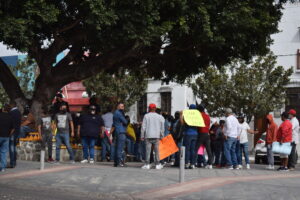
Nearly 70 were outside the municipal town hall with banners.
The message reminded them that it is the Secretary of Transportation (Setran) of the State of Jalisco, the only one empowered to issue permits and regularize the service providers of transportation platforms or Transportation Network Companies.
After this second demonstration in Chapala, some of the transporters met with the coordinator of advisors of the Municipality of Chapala, Juan Carlos Pelayo Pelayo, who invited them to denounce the alleged extortion by elements of the state police to the Public Prosecutor’s Office.
Pelayo Pelayo asked them to present proof of the accusation, but clarified that it was beyond the powers of the municipal government to ask the State police to stop patrolling the streets of the municipality. «Chapala is also Jalisco’s territory,» the public official was heard saying in a video posted on social networks by the Facebook account: Reporters Anonymous.
The protests stem from the fact that elements of the state police have allegedly taken cash from several of the drivers in their so-called «routine checks», which have intensified over the last three weeks.
The straw that broke the camel’s back was the alleged robbery of 7,500 pesos from a driver of the cars popularly known as «Uber ‘s», but which are not licensed Uber drivers, which makes them more vulnerable to this type of alleged abuse of authority.
The first protest that took place on February 7 with 30 drivers, in front of the State Police headquarters, installed in the Parque de la Cristianía, located to the east of the municipal capital of Chapala, has grown in number of protesters.
On this second occasion there were around one hundred cars that took to the streets to demonstrate, as opposed to the 30 units that protested on the first occasion.
Translated by Patrick O’Heffernan
Va dengue a la baja en Jalisco; solo hay un caso en lo que va del año
El mosco Aedes aegipty es el transmisor del dengue . Foto: Getty
Redacción.- Jalisco mantiene a la baja los casos de la enfermedad provocada por el mosco Aedes aegipty. El 2021 cerró con 95 por ciento menos contagios respecto al año previo y en lo que va del 2022 únicamente se ha confirmado un caso no grave de dengue.
Lo anterior se dio a conocer en la presentación del Informe de Acciones contra el Dengue 2021 el pasado martes 22 de febrero durante la Primera Sesión Ordinaria 2022 de la Comisión Interinstitucional «Unidad Transectorial para la Prevención y Control de Enfermedades Transmitidas por Vector en el Estado de Jalisco», encabezada por la Coordinadora General Estratégica de Desarrollo Social, Anna Bárbara Casillas García, y el titular de la Secretaría de Salud en la entidad (SSJ), Fernando Petersen Aranguren.
“Se requiere del compromiso de todos para mantener a raya esta enfermedad que es transmisible por vector y es muy importante que mantengamos esta baja incidencia, porque tenemos que continuar atendiendo asuntos como la pandemia por COVID-19 y otro tipo de padecimientos”, mencionó la Coordinadora.
La funcionaria estatal pidió a los asistentes refrendar su compromiso este 2022, tras los buenos resultados de la estrategia implementada. Recordó que el año 2019 Jalisco vivió una epidemia de dengue, que fue una presión para todo el sistema de salud.
Por su parte, Petersen Aranguren, en su calidad de Secretario Ejecutivo de esta Comisión Interinstitucional, expuso el Informe 2021, señalando que durante el año pasado en México se notificaron 37 mil 742 casos probables de dengue y de ellos se confirmaron 6 mil 746; y se registraron en todo el país 39 defunciones con una letalidad de 1.7 por ciento.

El Informe de Acciones contra el Dengue 2021 fue presentado el pasado martes 22 de febrero. Foto: SSJ.
“En Jalisco, para el cierre del año 2020, se registraron 4 mil 455 casos de dengue no grave, y en 2021 se registraron 153 casos de dengue no grave. A la semana epidemiológica seis en el 2020 se contaba con el registro de 39 casos de dengue, en el 2021 se tuvieron 16 casos y en el 2022 a la misma semana epidemiológica se contabiliza un solo caso”, destacó el titular de la SSJ.
En Jalisco a la semana epidemiológica número seis, se han notificado 132 casos probables de dengue en donde solo se ha confirmado uno correspondiente al municipio de Zapopan; una disminución del 95.2 por ciento, comparado con el año anterior, dijo el Secretario de Salud.
“La tendencia de los casos probables de dengue en las últimas cuatro semanas se ha mantenido a la baja. En este 2022, Jalisco ocupa el lugar número 15 a nivel nacional, por tasa de incidencia, y el octavo por el número de casos con solo un caso”, indicó Petersen Aranguren.
JALISCO FRENTE AL DENGUE
- Al cierre del 2021 se visitaron 2 millones 348 mil 849 casas.
- Día “D” eliminaciones masivas de criaderos: el año pasado se tuvieron 1,581 eliminaciones, 9 mil 100 toneladas de cacharros eliminados, mil 081 localidades intervenidas, 98 mil 310 llantas eliminadas. En lo que va del 2022 se han hecho 92 eliminaciones recolectando 407 toneladas de cacharros en 56 localidades y 6 mil 476 neumáticos.
- Al cierre del 2021 se fumigaron 97 mil 773 viviendas y en lo que va del 2022 se han trabajado 3 mil 570 viviendas.
- En cuanto a nebulización espacial, en 2021 se fumigaron 250 mil 385 hectáreas. A la semana número 6 del 2022 se han fumigado 19 mil 396 hectáreas
PARA SABER MÁS
La Organización Mundial de la Salud (OMS) advierte que ha aumentado de manera exponencial la incidencia de casos de dengue en el mundo y cerca de la mitad de la población mundial corre el riesgo de contraer la enfermedad.
Estima que cada año hay entre 100 y 400 millones de infecciones de las cuales más del 80 por ciento se trata de infecciones leves o asintomáticas.
El 13 de febrero de 2020, el Gobernador Constitucional del Estado de Jalisco, Enrique Alfaro Ramírez decretó en el periódico oficial del Estado, la creación de la Comisión Interinstitucional “Unidad Transectorial para la Prevención y Control de las Enfermedades Transmitidas por Vector en el Estado de Jalisco”, la cual ha fungido como un órgano auxiliar de la administración pública centralizada, con el objetivo de planear, programar, coordinar y fomentar la cooperación de las dependencias, ciudadanía y sectores organizados, en la prevención de enfermedades transmisibles por vectores.
© 2016. Todos los derechos reservados. Semanario de la Ribera de Chapala
